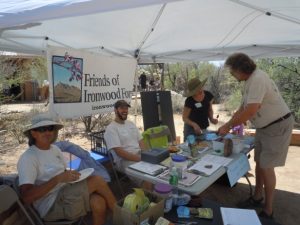Source: Joshua Bowling, The Republic/azcentral.com, October 18, 2017
Arizona State Parks Foundation
Arizona State Parks and Trails Brings Home the Gold Medal for Best Managed State Park System
Source: Arizona State Parks and Trails Press Release – September 26, 2017
Arizona State Parks and Trails today won the Gold Medal for best managed state park system in the nation from the National Recreation and Park Association (NRPA). The award was announced this morning during the national NRPA conference in New Orleans, Louisiana.
“This is a tremendous achievement that benefits everyone in our state – from residents to tourists,” said Governor Doug Ducey. “Winning the Gold Medal is a testament to the hard work, collaboration and innovation that Arizona State Parks and Trails demonstrated to get us to this point.”
 Arizona State Parks and Trails was selected as a Final Four candidate in May, along with Tennessee State Parks; Washington State Parks and Recreation Commission; and Wyoming State Parks, Historic Sites, and Trails. Over the last two years, Arizona State Parks and Trails has established a self-sufficient funding structure, achieved record visitation and revenue and implemented a plan to reinvest in the system and create new parks.
Arizona State Parks and Trails was selected as a Final Four candidate in May, along with Tennessee State Parks; Washington State Parks and Recreation Commission; and Wyoming State Parks, Historic Sites, and Trails. Over the last two years, Arizona State Parks and Trails has established a self-sufficient funding structure, achieved record visitation and revenue and implemented a plan to reinvest in the system and create new parks.
“This Gold Medal win is not just about the staff of Arizona State Parks and Trails,” said Sue Black, Executive Director of Arizona State Parks and Trails. “This is about everyone in Arizona who contributes to our success or gets to enjoy our beautiful parks. It’s a huge honor to be considered the best-managed state park agency in the country, and we hope everyone will get out and see these amazing parks first-hand.”
To celebrate making it to the Final Four and hear the Gold Medal winner announced, agency partners, stakeholders and constituents gathered at the Arizona State Parks and Trails Outdoor Recreation Information Center on Tuesday morning as the event was live-streamed on Facebook from New Orleans. Executive Director Black accepted the award.
The Gold Medal Award honors state park systems throughout the United States that demonstrate excellence in long-range planning, resource management and innovative approaches to delivering superb park and recreation services with fiscally sound business practices.
For information about all 35 Arizona State Parks and Natural Areas, the Trails and Off-Highway Vehicle Programs and State Historic Preservation Office call 1-877-MY-PARKS or visit AZStateParks.com.
PRESS CONTACT: Michelle Thompson at (602) 542-1996 or (480) 589-8877 – Email: pio@azstateparks.gov
Arizona Game and Fish Accepting Applications for 2018 Heritage Fund Grants
Source: Arizona Game and Fish Department Press Release – August 11, 2017
The Arizona Game and Fish Department is accepting applications for more than $400,000 in Heritage Fund grants. The deadline to submit an application is Tuesday, Oct. 31, 2017 to be eligible for grant funding, which will be available through a competitive application process in the following categories: environmental education, outdoor education, schoolyard habitat, urban wildlife/habitat, public access; and Identification, Inventory, Acquisition, Protection and Management (IIAPM).
funding, which will be available through a competitive application process in the following categories: environmental education, outdoor education, schoolyard habitat, urban wildlife/habitat, public access; and Identification, Inventory, Acquisition, Protection and Management (IIAPM).
In addition to government agencies, the department welcomes non-profit organizations to apply for a Heritage Grant as eligible applicants. This eligibility applies to any non-profit group which meets the internal revenue service definition of a 501(c) organization.
The Heritage Fund was created after voters approved an initiative in 1990 and is funded through Arizona Lottery ticket sales. Heritage funding goes toward conservation efforts such as protecting endangered species, educating students and the general public about wildlife and the outdoors, and creating new opportunities for outdoor recreation.
The grant program was established by AZGFD in 1992 as part of the overall Heritage Fund program. The grants were initially developed as a way to promote outreach to enhance important partnerships and generate fresh approaches in support of the department’s mission. Since the grant program’s inception, the department has awarded more than $16 million and supported more than 800 projects throughout the state.
Applicants for this year’s grants should refer to the documents on our Heritage Grant web page for guidance on applying. The documents include the Heritage Grant application manual, the grant application form and the various “Heritage Grant Funding Window” documents, which describe eligibility information and provide specific eligibility criteria listed within each grant sub-category.
Potential grant recipients must have a project that is either located in Arizona or involves research in which the wildlife or its habitat is located in the state and meets the requirements in the funding windows.
Proposals and applications for these grants can be submitted either by e-mail to rbeck@azgfd.gov or mailed to Arizona Game and Fish Department, Attn: Wildlife Grant Administrator, 5000 W. Carefree Highway, Phoenix, AZ 85086. No faxed applications will be accepted.
Applicants can submit grant applications up until the application deadline of 5 p.m. (MST)Tuesday, Oct. 31, 2017.
Arizona Conservationists: Save Our National Monuments
Source: By William Thornton and Tom Hanagan, Special to the Arizona Daily Star, June 4, 2017
The president’s executive order to review national monuments could recommend downsizing or abolishing monuments over 100,000 acres designated since 1996. A brief history of the Antiquities Act and case study from Ironwood Forest in our own backyard might clear up some misconceptions.
Signed into law by Theodore Roosevelt on June 8, 1906, the Antiquities Act gives the president authority to, by proclamation, create national monuments from public lands to protect significant natural, cultural or scientific features. The law was necessary after decades of looting and desecration at Native American sites such as Chaco Canyon. Roosevelt went on to designate 18 national monuments. Grand Canyon and Petrified Forest in Arizona have been upgraded to National Park status.
National Monuments are owned by the American people. Each of Roosevelt’s successors, Democrat or  Republican, has used the Antiquities Act to protect lands in the public domain. Opponents of new national monuments have characterized the process as “arbitrary, capricious” and subject to manipulation by “tree huggers” who draw lines on a map, and before you know it, the public is “locked out” and economic activity comes to a screeching halt.
Republican, has used the Antiquities Act to protect lands in the public domain. Opponents of new national monuments have characterized the process as “arbitrary, capricious” and subject to manipulation by “tree huggers” who draw lines on a map, and before you know it, the public is “locked out” and economic activity comes to a screeching halt.
In reality a monument proposal must make a compelling case that the area contains natural or cultural features worthy of protection. For Ironwood Forest these features include: the only surviving indigenous herd of desert bighorn sheep in the Tucson area, the largest stand of desert ironwood trees, numerous archaeological sites and critical habitat for an endangered cactus.
What does monument designation mean for Ironwood Forest?
 Monument land has benefited from thousands of hours of hands-on work by hundreds of volunteers from the Friends of Ironwood Forest, Arizona Native Plant Society, Bighorn Sheep Society, Arizona-Sonora Desert Museum, Sierra Club and many others. Invasive buffelgrass is one of the most serious threats to our Sonoran Desert. A coordinated effort to control it is making progress, but it may not have been possible without monument designation.
Monument land has benefited from thousands of hours of hands-on work by hundreds of volunteers from the Friends of Ironwood Forest, Arizona Native Plant Society, Bighorn Sheep Society, Arizona-Sonora Desert Museum, Sierra Club and many others. Invasive buffelgrass is one of the most serious threats to our Sonoran Desert. A coordinated effort to control it is making progress, but it may not have been possible without monument designation.
Free access is available with restrictions deemed necessary to protect the resource. Hunting is permitted subject to regulation by the Arizona Department of Game and Fish. Privately owned parcels within the monument remain available for use subject to local zoning laws. When funds are available, land may be purchased from willing sellers. Land has been donated, but the BLM cannot seize or force the sale of private land.
Historically, mining and ranching have been major economic activities in the area. Grazing leases on monument land remain in force and are renewable. The Pioneer Materials quarry continues to operate.
Outdoor recreation is big business in Arizona, bringing $10.6 billion in consumer spending, $787 million in state and local tax revenue, and supporting 104,000 Arizona jobs, according to the Outdoor Industry Association. Parks and monuments are a big part of the picture.
National monuments do not belong to the president or Congress. They are our lands and heritage but will remain so only if we speak up. Comments may be submitted through monumentsforall.org or regulations.gov. Deadline is July 10. Also, please contact Senator Flake and Senator McCain and your congressperson and respectfully request that they stand up for our monuments.


You must be logged in to post a comment.